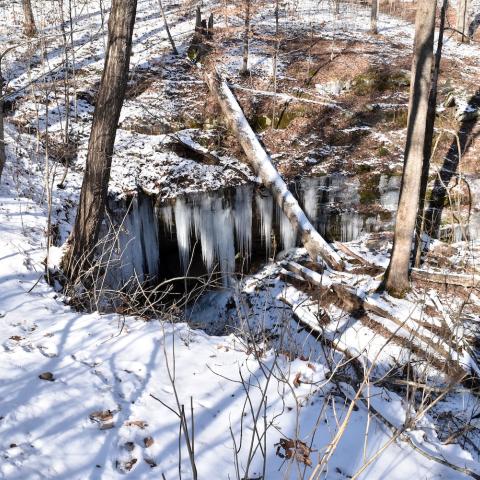
The 1851 Pictorial Guide to Mammoth Cave used text and a few sketches, like this one of the "Entrance to the Cave," to describe the cave to prospective travelers/NPS
Editor's note: The following article was written by Vickie Carson, the public information officer at Mammoth Cave National Park.
How do you decide on a vacation destination? Which route to take, attractions to visit and where to spend the night?
No doubt you use online info. Star-ratings. Pics. Travel blogs. Information is short and to the point, like this 2015 review of Mammoth Cave:
“Absolutely wonderful place to visit. Ordered tickets ahead of time online about three weeks out. Glad I did as they were sold out when we got there. The guides (took two different tours) were fun yet were super examples of what you would expect a Park Ranger to be like. Highly recommend a lantern tour for a whole different experience. Check one off of the bucket list! Would go again.” –Me P.
How did people find out about Mammoth Cave in years past?
“We have a long history here are Mammoth Cave,” said Superintendent Sarah Craighead. “Travel to Mammoth Cave dates back to 1816 when the first guided cave tours began. Visitors often wrote detailed travelogues or journals about their experiences. In this anniversary year, it is fun to look back at old accounts.”
In 1851, the Reverend Horace Martin wrote an article, Guide to Mammoth Cave, that was published in the Pictorial Guide to the Mammoth Cave (Stringer & Townsend); Illustrated in the First Style of Art, by S. Wallen, Jno. Andrew, J.W. Orr and N. Orr.
(Be aware: the “pictorial guide” contains written descriptions and a few sketches. At this time the written word was the primary form of communication. The first photos of Mammoth Cave were taken in 1866, fifteen years after this guidebook was published.)
Below are excerpts from Rev. Martin’s article, tracing the walk down the hill to the Historic Entrance, through Houchins Narrows, and into the Rotunda.
“…And now for the Cave, well and aptly designated Mammoth; and as a natural object, perhaps unequalled by any other in the world, certainly unsurpassed.
“In order to explore only one of its avenues, which is nine miles in extent, the visitor starts immediately after breakfast. The entrance to the Cave is about two hundred yards from the back of the hotel. Leaving it, the expectant tourists pass down a beautiful ravine, having on each of its sides towering trees, their foliage forming a beautiful arch overhead, so umbrageous as to shut out all vision of the blue sky. About the trees grape-vines are entwined, and flourish in luxuriance…Descending gradually to the bottom of the dell, and turning sharply round to the right hand, the visitor approaches the entrance of the Mammoth Cave.
“He is now under its arch, having made a descent of some thirty feet of rude stone steps. Before him is a small stream of water. It falls from the front of the crowning rock, its sound being wild and unequal…
“We proceed through this passage, which is called “the Narrows” for a short distance, then making a gradual descent, our friends find themselves in the great vestibule or antechamber of the cave. How awful is now the surrounding darkness! No where can there be discovered the least glimmering of light. The eye searches for it, but in vain. Blackness reigns. It is under, above, around you …
“The guide, who knows the power of antithesis, and is an adept too, in dramatic effect, now lights a few fires, by the aid of which you ascertain that you are in a basilica of an oval form, of some two hundred feet in length by one hundred and fifty in width, with a flat and level roof between sixty and seventy feet high…”
The 1851 travelogue differs from today’s travel blogs, but the Mammoth Cave intricately described by Rev. Martin is the same Mammoth Cave that visitors see and enjoy today.


 Support Essential Coverage of Essential Places
Support Essential Coverage of Essential Places







Comments
Ah, the luxuriant language of the 1800's! What a contrast with today's vocabulary deprived electronic communications -- OMG, LOL and cool dude!